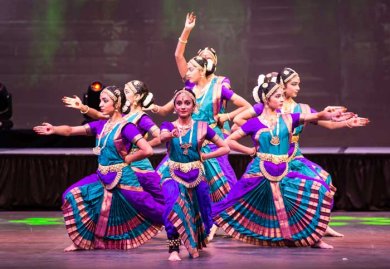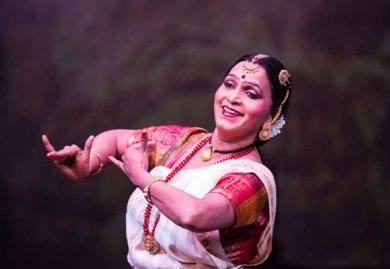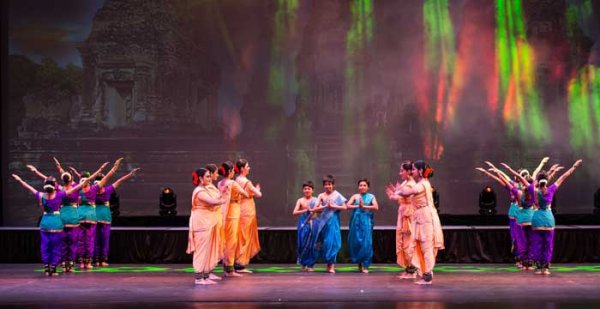
|   |

|   |
San Francisco Bay area soaks in Bhakti - Poornima Ramaprasad e-mail: poornima-at-sbcglobal-dot-net Photo Credit: Ravishekar photography January 15, 2016 San Francisco Bay area is blessed to have wonderful performers of Indian dance and numerous performance venues. PAMPA, a well known school of Bharatanatyam and Kathak presented a thematic show ‘Bhakti’ to a packed audience of nearly 1000 on November 14, 2015 at the San Jose Center for Performing Arts, a premium performance venue in downtown San Jose. Choreography and direction for this production was by the artistic director of PAMPA dance academy, Nirmala Madhava. Nirmala is proficient in both Bharatanatyam and Kathak dance forms. Further, Nirmala is trained in Western Tap dancing. With her in depth training and knowledge of several genres, Nirmala experiments and presents fusion performances and is known to be one of the most upbeat choreographers and soloist of San Francisco Bay area. The proceeds of this event were for the benefit of Sri Krishna Brindavana, an upcoming temple in the Bay area. Performing for the temple, the theme ‘Bhakti’ (devotion) was very apt. True to its name, all the items presented by Nirmala and team were centered on this concept. What made this performance unique was the common thread among the items, which was presented as a conversation between poet Rabindranath Tagore and scientist Albert Einstein. It is said that on July 14, 1930, Albert Einstein welcomed into his home in the outskirts of Berlin the Indian philosopher Rabindranath Tagore. The two proceeded to have one of the most stimulating, intellectually riveting conversations in history, exploring the age-old friction between science and religion. They also had a very deep discussion about various aspects of Indian music and dance, and their relation to philosophy and quantum mechanics. This conversation formed the thread to weave the magic of Bhakti. Each of the items presented had a prelude with the conversation between the two great minds, and they naturally led to each of the compositions. The program began with an invocation to Lord Ganesha, with his 12 names. After this came the adulation to the Sun God and the Shanti mantra. These were group items, presented by the senior students of Pampa dance academy.  Students of Pampa In the conversation between Tagore and Einstein, Tagore explained the importance of Omkaara, and how the Earth, which is considered as mother in Indian belief, was composed of divine vibrations. This segment was followed by a wonderful presentation of the composition “Omkarakarini” (in raga Lavangi), a composition of Dr. Balamurali Krishna. This was a solo presentation by Nirmala Madhava, in which she portrayed the divine mother as one who gives love and peace, the 'Omkaara akaarini' and the other, one who destroys 'mada' and 'ahankaara' and punished the evil as ‘mada-ahankaara kaarini.’ With her seamless portrayal and expressive abhinaya, Nirmala won the hearts of one and all. Easily, this was the best presentation of the evening. Next, the great minds had an exchange of ideas regarding the energy that pervades the universe. In the Indian thought, Tagore explained that the energy of time and timing evolves from Shakti. Shakti is nothing but a form of Shiva, the entity that eventually deconstructs the present to enable the creation of future. Aptly this was followed by a composition in the raga Shivashakti. Gurudev then described how the destruction of existence leads to the path of new creation. Sustenance of natural order has creation and destruction at the opposite ends. Vedas attribute the destruction to the divine force called Shiva. Shiva means eternal joy, without any tinge of sadness. This joy is humongous like Mount Kailas. To convey this joy, a Shiva Tandava Nritya was presented.  Nirmala Madhava Gurudev explained to Einstein how according to Vedas, energy propagated into vibrations and how through vibrations matter is created. These vibrations are indeed a form of Nada Brahma and the energy of all such action is represented by Lord Krishna. Who cannot be mesmerized by Krishna’s stories? And bringing out the energy, happiness, charm, playfulness or the divinity of Lord Krishna is one of Nirmala’s foremost strengths. She presented a very meaningful Ugabhoga of Purandara dasa “Baliya manege Vaamana bandante” followed by Kanakadasa’s epitome composition “Baaro Krishnayya.” Over the years Nirmala has performed for this composition at a number of thematic events, but each time, it is as thrilling an experience. With each charana, a different story of Lord Krishna was portrayed in an enchanting way.  The group went on to perform a few items in both Bharatanayam and Kathak styles, for which the choreography and costumes were a treat to watch. Again here, the theme was centered around Lord Krishna. Nirmala used a Meera bhajan and a keerthana on Lord Krishna to enact several stories including that of the demon Hiranyakashipu, where the Lord takes on the Narasimha avatara and the Kalinga Mardhana episode. She was ably supported by her students in this item. Lighting by Bindu Madhava was vibrant and successful in creating the required mood for each situation - be it the graceful Krishna snatching away clothes from Gopikas or Lord Narasimha killing the demon Hiranyakashipu. Purna Prasad as Rabindranath Tagore was convincing. Sugunendra Tirtharu, the Pontiff of Puttige Matha graced the performance by his presence, and blessed the audience. The contented audience donated generously for the cause. All in all, the Bhakti presentation soaked the dancers and the audience in bhakti and was fulfilling for one and all. Poornima Ramaprasad follows Indian classical music and dance forms. She reviews Indian dance and drama events in the San Francisco Bay area from time to time. |